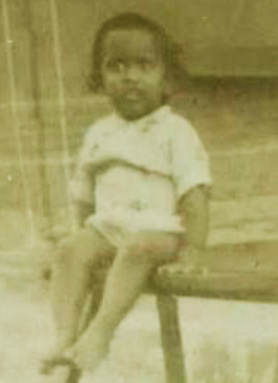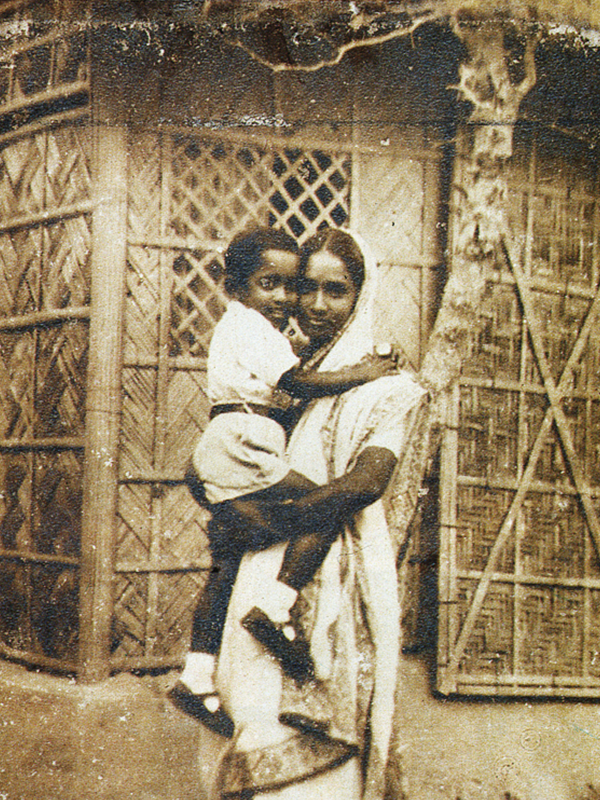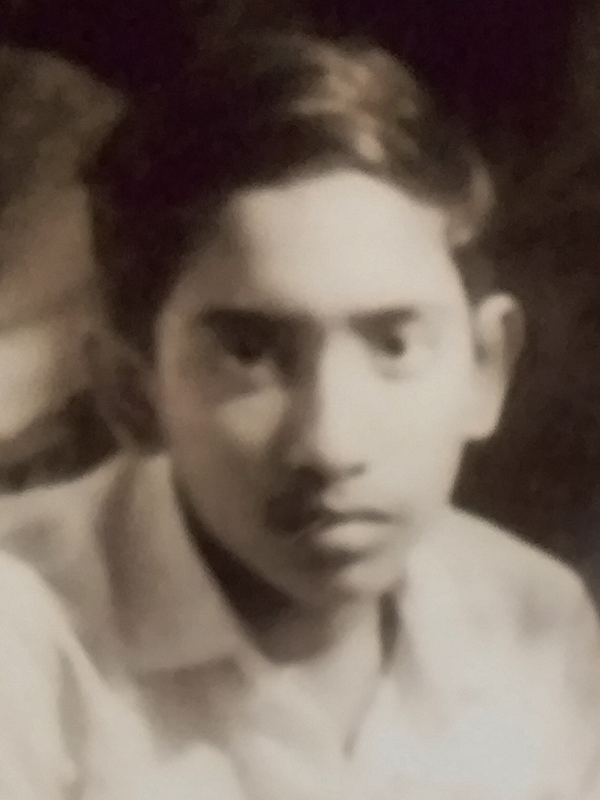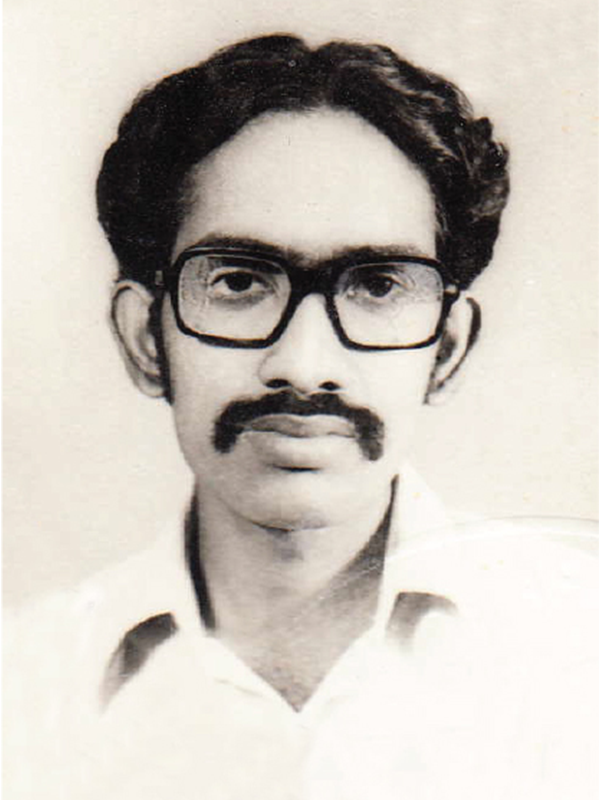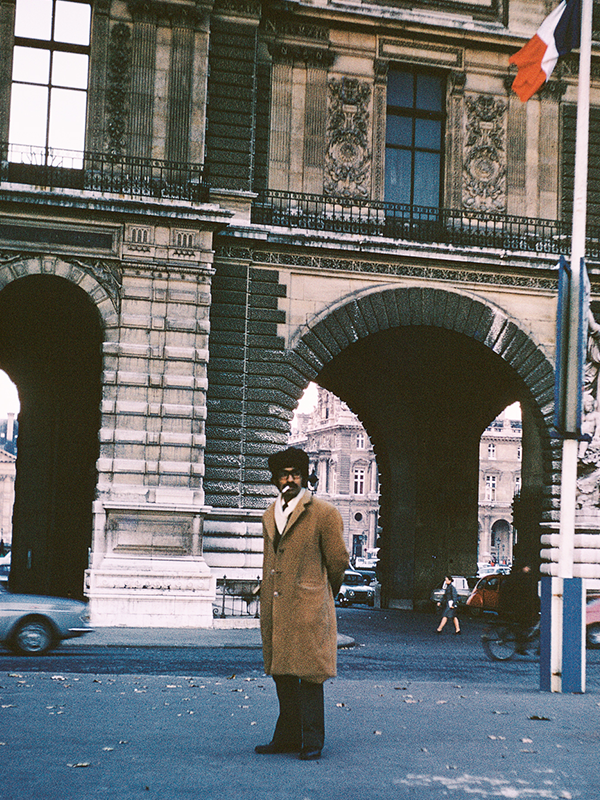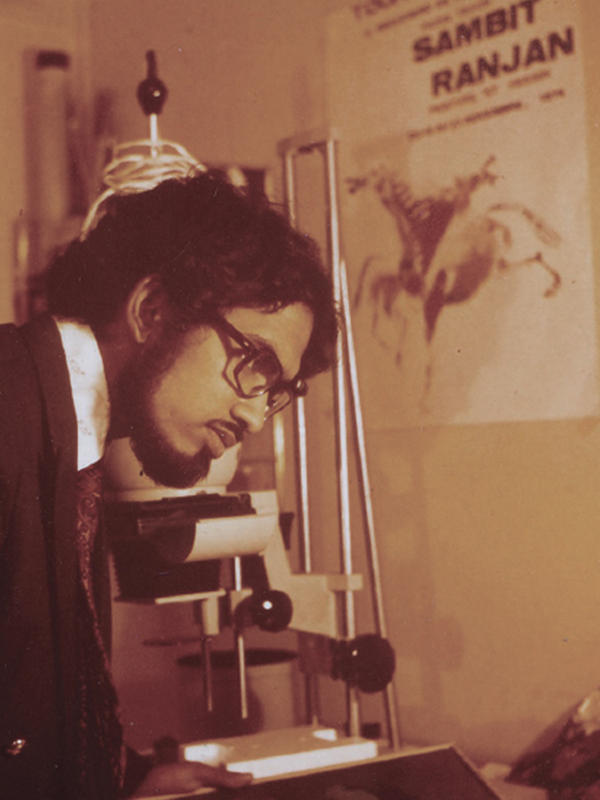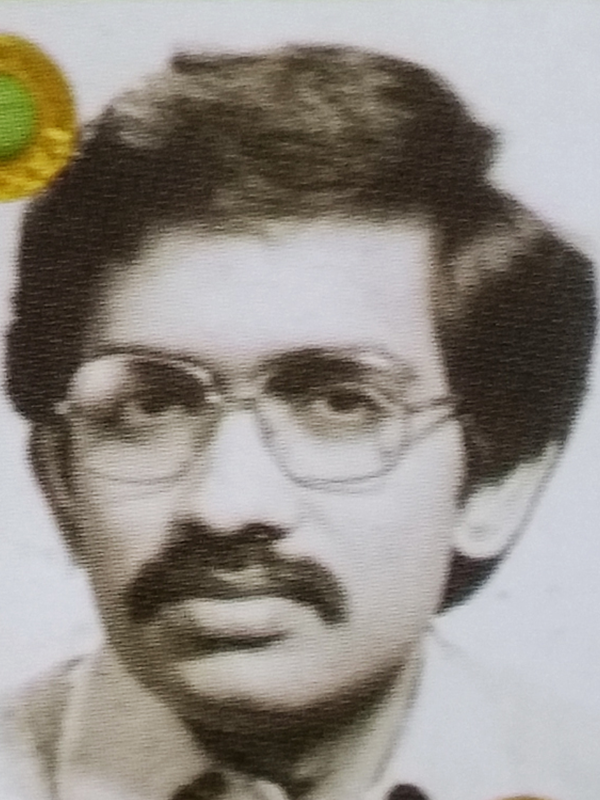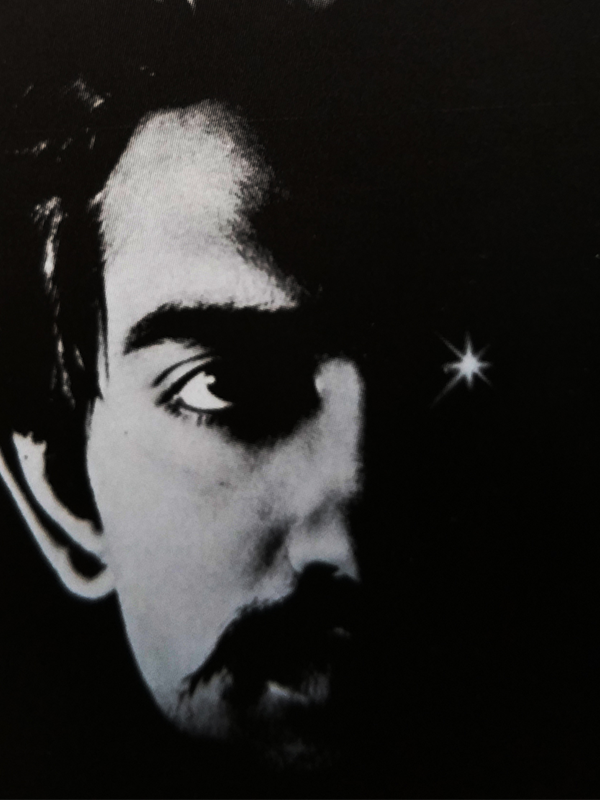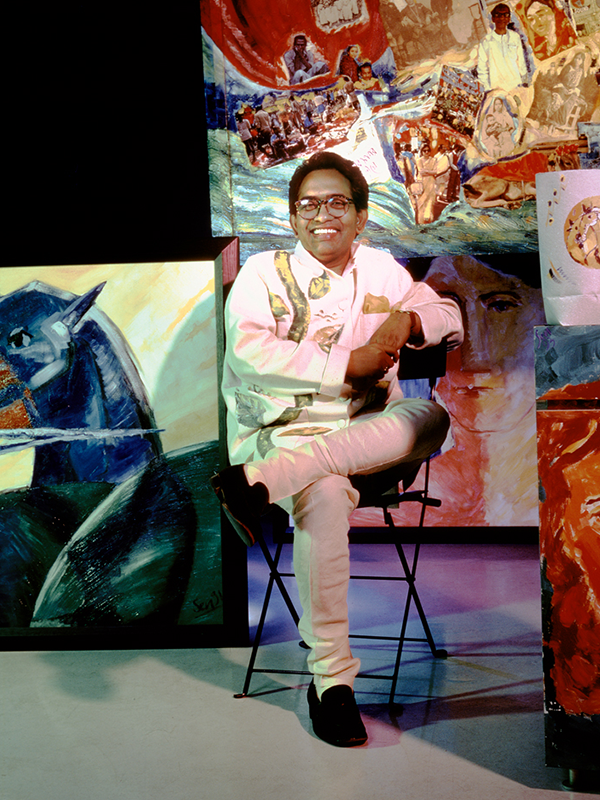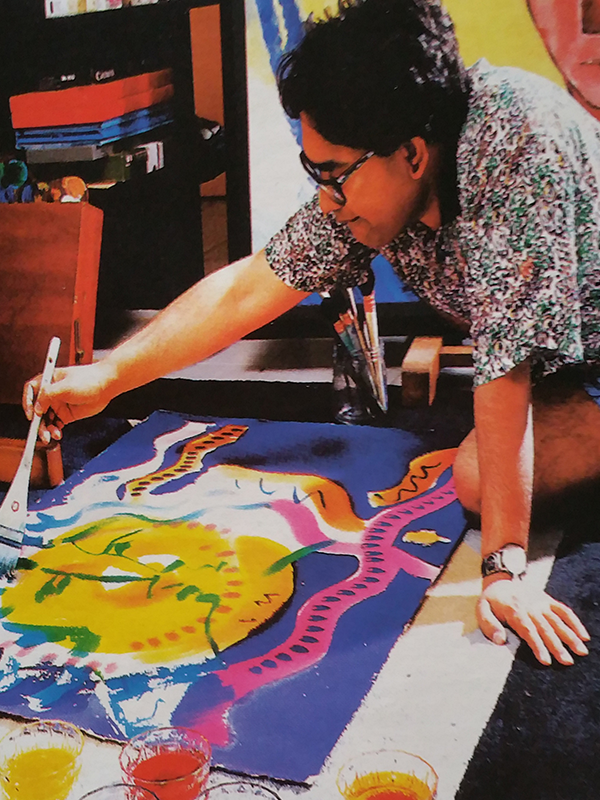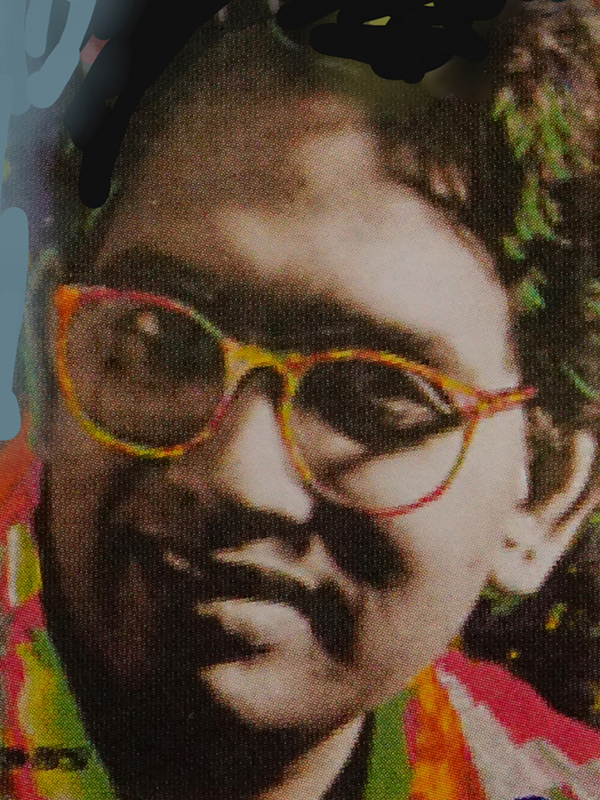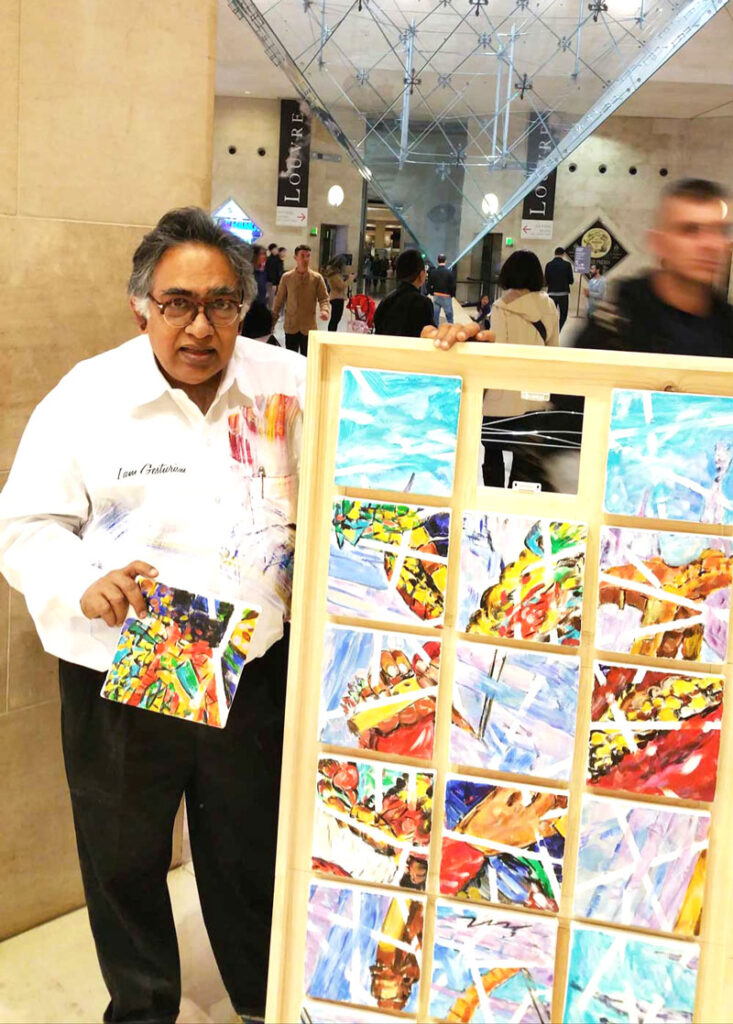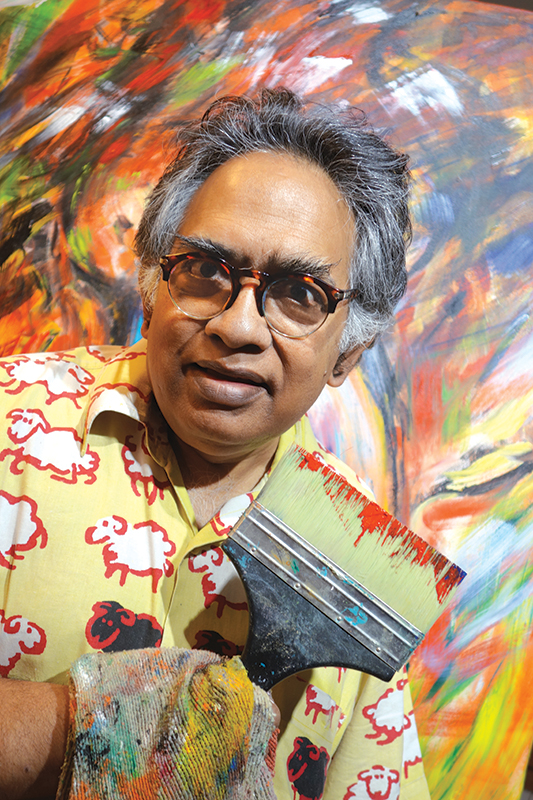TIMELINE
At the age of 5, Sen with his mother in front of their thatched roof, bamboo wall and mud floor squatted home at Shohidnagar refugee camp, 50 km outside Calcutta. Sen grew up here without electricity, sanitation or potable water. His parents had come here as refugees from East to West Bengal during the chaotic partition of India and Pakistan on religious grounds (East Bengal was renamed East Pakistan, and liberated as Bangladesh since 1971). More than a million were killed in riots and 15 million displaced during Independence. From an early age Sen was enormously influenced by the artisans in his neighbourhood.
Many of these East Bengal refugees practiced different crafts for livelihood generation. Watching shell bangle makers, idol and doll craftsmen and clay potters, Sen got involved with clay modeling. He used to spend more time drawing and painting than in his school studies. Subhinoy, an artist friend of his parents who lived outside the refugee camp, inspired Sen to hone his drawing skill. However, he advised Sen never to become an artist to avoid ultimately dying in poverty as his experience was that art has no future in India.
Sen’s father, an active Communist Party leader, was anti-British. He influenced Sen about France being very advanced in art, human rights and camaraderie. Adolescent Sen got immersed into French art and culture while going to Chandernagore, the erstwhile French territory across the Ganges river from his home. Drawing and painting had become a part of his life by then.
Sen’s academic learning of art started at the Government College of Art and Craft, Calcutta, the first British art school in Asia set up in 1869. Sen was deeply impressed by the Modern Art Movement in France since 1870. This sparked his big dream to go to France by any means.
Sen fulfilled his big dream by dropping out of his studies midway, and daringly travelling to France with just $8, the only amount he could muster then. His mother had sold her only asset, a gold marriage bangle, to buy him a return air ticket for Rs 2700 (US$ 349 in 1973) with 3 months visa permit. Here is Sen on 16 November 1973, his second day in Paris, in front of Louvre Museum where he could not afford to enter.
Sen’s first job in France was as a sweeper in an art lithography studio 10 km from Paris. With enormous initial struggle and timely help from kind scientist Dr Pyne, he managed to stay on in France permanently, beyond the 3 months visa granted to him. At the same time he was studying at École nationale supérieure des Beaux-Arts and the School of Design ESAG (Penninghen). In 1974 he had his first solo art exhibition in Paris.
From 1977 onwards Sen could not continue his academic art and design school because of huge money crunch. He found a job in a design and communication firm for livelihood generation, but continued to paint on a vast scale.
Sen by then had acquired an important position in the profession of design communication and became among the most sought after designers in France and across the world. He also got his French nationality in 1984. He continued to exhibit his paintings in different countries.
Sen’s paintings displayed bright colours with vegetal and human expression. He says everything in life is attainable with love and courage, so he coined “love and courage” to be his signature. His painting exhibitions continued alongside in several places.
“Never lose your bold brushstrokes, this gesture is unique to you,” one of his Parisian art professors would always tell him. Having ingrained all the Western art movements, Sen worked towards finding his own direction in art. He invented a new ideology he called Gesturism Art, a style that uses his bold brushstrokes. In Gesturism Art he incorporates his philosophical angle of human life which has a multitude of gestures from birth to death.
From the age of 44, Sen started to come back and forth to India. This gave him quite a different perspective of his country of origin which he had not seen when he left it a quarter century earlier. Within his European framework where he grew up professionally post his teens, he suddenly saw an irreverent usage of colour in India. There were no boundaries, no regimentation, no pattern in the usage of colour. Different people extravagantly used colour for their different types of social to religious to livelihood to lifestyle requirements. There is no colour code to follow. Sen found this to be a huge palette of the freedom of expression. It gave a new dimension to the visual expression of his Gesturism Art.
Sen started to divide his time equally between India and France. In India he discovered the most heterogeneous society of the world where there is no given discipline in social, cultural and working life. In every sense of life he observed physical disorder. Everybody is compelled to find his or her own solution, somewhat like embracing the great living character of survival of the fittest. Sen transported this disorder by turning it into a new style of painting called désordre harmony.
By now Sen was being invited by all the major French salons, city municipalities in France and different galleries across the world to exhibit his Gesturism Art in either solo or group exhibitions. A great French art critic, Patrice de la Perrière defined Sen’s art as having an encrypted aspect for the viewer to discover. Finding juxtaposed treatment of abstraction and figurative in his works of art, he gave birth to the definition “Abstract with hidden figuratives.” This grand gesture was a big turning point in Sen’s art. People in different countries also get similarly curious and love to identify the figuratives in his abstract paintings. They take time to enter into his paintings in a systematic trajectory. Splashes of colour with big brushstrokes where living beings hide within the abstract form, that’s the hidden aspect of his expressions that constitute his style of Gesturism Art work.

Sen was born 1954 in Shohidnagar squatter refugee camp near a small railway town, 50km from Calcutta. His family were displaced Hindus from East Bengal, victims of India's violent religious partition for independence 1947. Around 20,000 refugees inhabited this 9sq.km abandoned area lacking basic amenities like drinking water, electricity, and sanitation. Sen’s mother became his staunchest art supporter because she observed her 3-year-old son had started non-stop drawing on their mud floor home.

Sen at age 5 with his school-teacher mother in front of their thatched roof, bamboo wall home. Her training was, “Poverty should never destroy cleanliness, emotion and civic sense.” She always protected him with cultural epic stories to deviate his mind away from their poverty and vulnerable refugee camp prone to destructive natural calamities. Monsoons would flood their home while stormy winds would blow away their hay roof shelter.
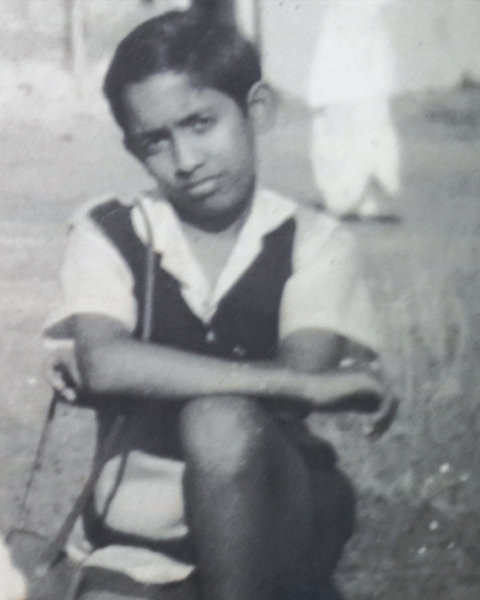
To sustain themselves, Sen's refugee neighbours would craft creative items like shell jewellery, colourful dolls and crockery from mud. Their expressive use of form, colour, and symbols sparked Sen’s inclination for fine art. He spent more time drawing and painting than in school studies. Subhinoy, an artist neighbor, inspired Sen to hone his drawing skill. His warning that art has no future in India, may have triggered Sen’s resilient mind to leap forward through painting.
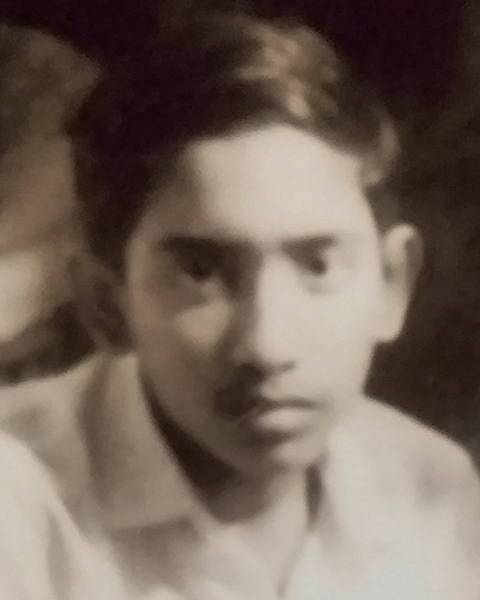
Sen had damaged his eyesight watching a solar eclipse. Flickering kerosene lamps at nighttime further aggravated it. To save his eyesight, his mother took the radical step of quitting the refugee camp. She opened a kindergarten school to increase earnings, rented a middle-class brick-and-mortar locality with electricity and tap water. Fourteen-year-old Sen’s pleasure here was juxtaposed with grief in leaving his grandmother, childhood friends and artisans. His all night working habit started from here.

Sen’s academic learning started at the Government College of Art and Craft, Calcutta, the first British art school in Asia established in 1869. Here French Modern Art since 1860 enamored him. Earlier, French colonial architecture in Chandernagore across river Ganges from his home had captivated him. Also, his Marxist father had once casually said that France encourages painters with freedom of expression. So Sen became determined to go to France by any means.

On his second day in Paris, Sen is outside Louvre Museum as he had no money to enter. He dropped out midway from his Kolkata art college to daringly travel to France with just $8 he could afford. His mother bought him a return air ticket by selling her gold marriage bangle for Rs 2700 (US$ 349 in 1973). With a 3-month visa and his art portfolio, Sen arrived Paris on 17 November 1973.
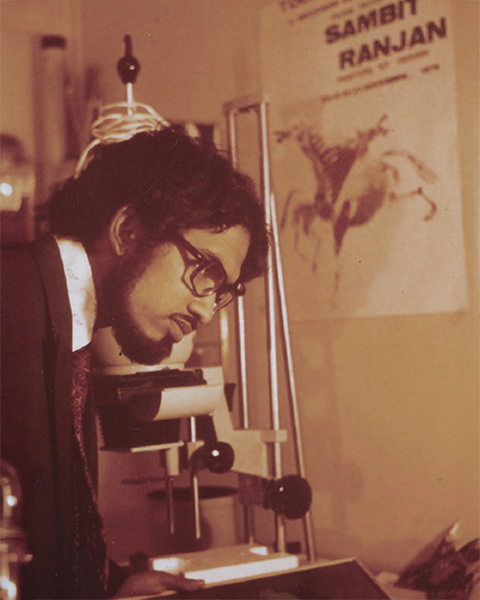
With initial struggle and timely help from kind scientist Dr Pyne, Sen stayed on in France. His first job in Cachan, 6 km from Paris, was as a sweeper in a lithography printing studio. Famous artists who frequented this printshop helped Sen have his first solo art exhibition in Paris 1974. Simultaneously, Sen’s art portfolio helped him enrol at École nationale supérieure des Beaux-Arts for fine art, and ESAG Penninghen (Académie Julian) for applied art.
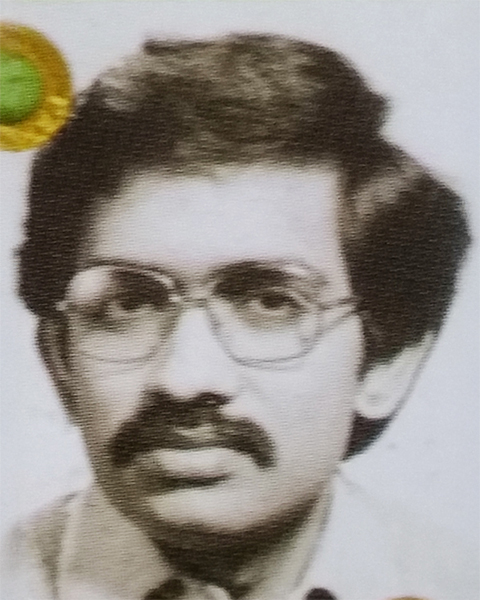
From 1977 onwards, Sen discontinued his academic fine art and design schools because of money crunch. He was supporting his family in Paris as well as parents and relatives in India. He found a job in a design and communication firm, persistently pursued applied art as a designer but continued to paint. He openly acknowledges that aside from his Indian school leaving certificate, he holds no official university degree.
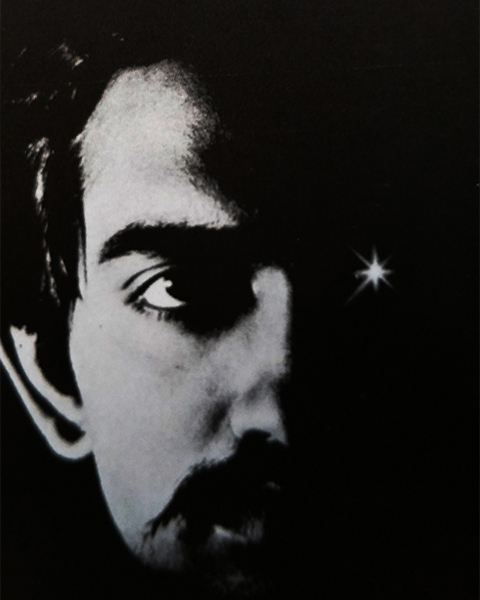
By the 1980s, Sen had risen professionally to acquire important positions in strategic design communication. He was among the most sought after designers and strategy consultants in France and across five continents. In this role, he infused art into industrial design, collaborating with some of the largest French and international corporations. In 1984 he got his French nationality. He continued to paint and have solo art exhibitions in different countries.
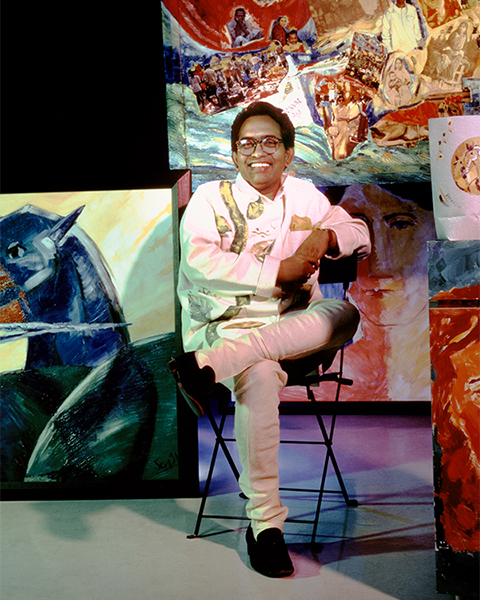
In Paris, French art and culture became the heartbeat of Sen’s life. Its imaginative spirit was so compelling that despite multiple lucrative offers to migrate to the US, he chose to remain in France. The rich legacy and generous creative community of France continue to inspire and shape his work till today. Sen says everything in life is attainable with love and courage, so he coined “love and courage” as his sign-off motto.
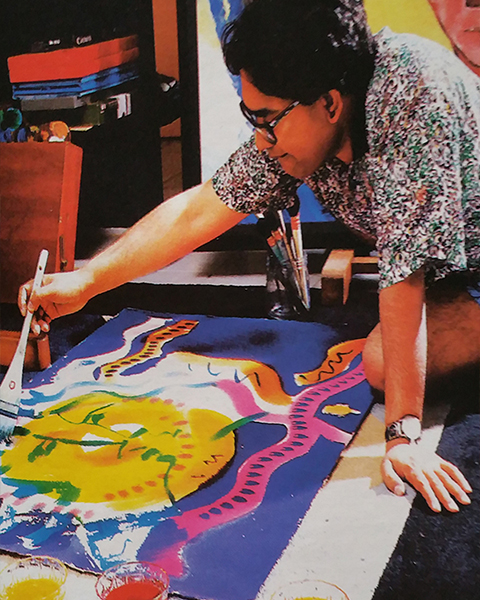
One of Sen’s Parisian art professors used to tell him, “Never lose your bold brushstrokes, this gesture is unique to you.” Having ingrained all the Western art movements, Sen worked to find his own style in art. He invented Gesturism Art, a new ideology that uses bold brushstrokes. In Gesturism Art he incorporated his philosophical angle of human life which has a multitude of gestures from birth to death.
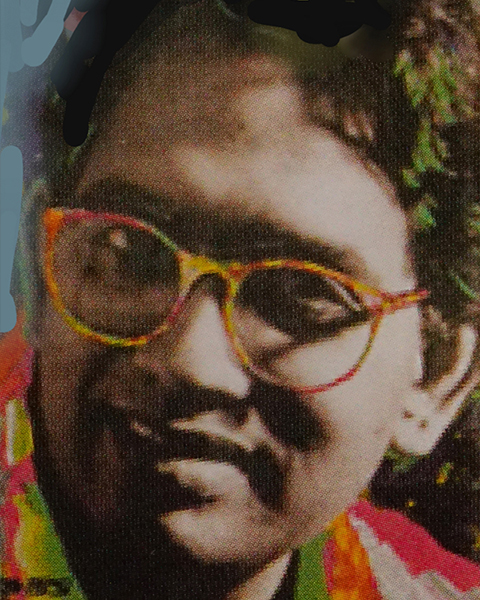
From 1973, after landing in France, Sen rarely visited India. But from 1998, his India visits increased beyond Bengal. He suddenly saw a different perspective, an irreverent usage of colour with no boundaries, no regimentation, no usage pattern, no colour code to follow. Different people extravagantly used colour for their different types of social to religious, livelihood to lifestyle requirements. This free expression of colour gave a new dimension to Sen’s paintings.
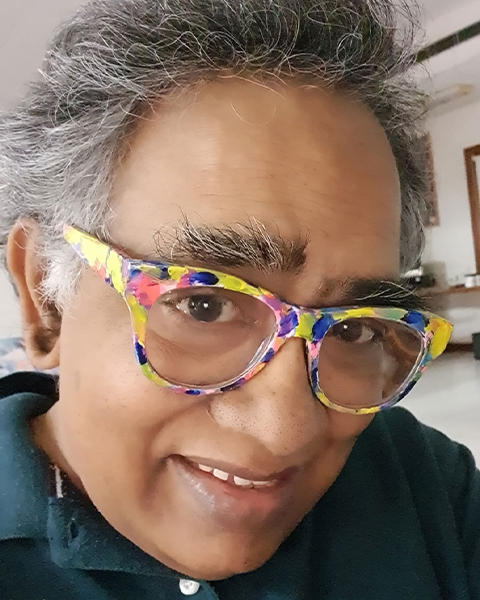
Sen was being invited by major French salons, French city municipalities and galleries across different countries to exhibit his paintings. Renowned French art critic, Patrice de la Perrière said his art has an encrypted aspect for viewers to discover. He found Sen’s paintings combine two separate existing European art movements of Abstract and Figuratives. So he coined the definition “Abstract with hidden figuratives.” This grand recognition became a turning point in Sen’s new style art.
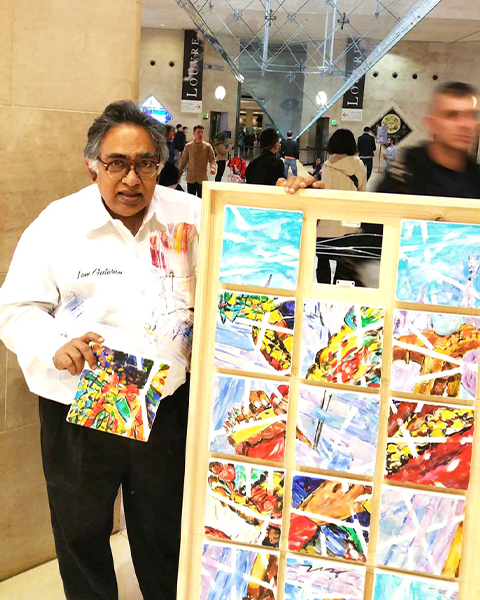
Sen exhibiting at the Louvre. In 2008, observing physical disorderliness of living life in India, he created paintings that have multiple canvases that viewers themselves can interchange. He believes painters do not retire. That’s why he dismisses his resilience to be accomplishment, such as exiting his refugee camp penury, to his decisive dive into uncharted territory for art, to exhibiting in the world’s art pinnacle Louvre in Paris. Rather he’s constantly in a working mode.
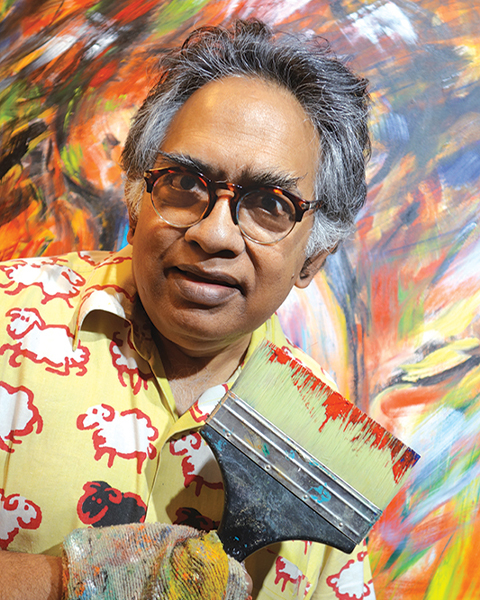
The French approach of linking artistic movements to distinctive ideologies with stylistic expressions has profoundly transformed Sen’s craft. From 50 earlier, he now paints 150 paintings per year. His creative process incorporates four self-discipline principles: Singular substance of crafting an unseen, recognizable visual style; Consistency of style in his paintings; ensuring his paintings have Universal Appeal; and making different Series to expand one idea into a storyline of multiple works.
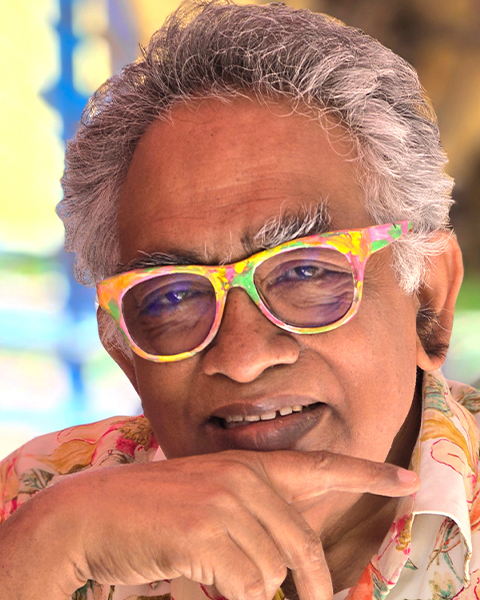
Sen expands his imaginative substance by travelling the world with curious observation. His paintings are nurtured by civilizations of different countries, geographical ornamentation, people’s attitude and behavior, architectural context and non-touristic discoveries. For example, bridges from the Middle Ages inspire him for being evolving and ahead of time in engineering technique, alongwith having a certain sense of aesthetics. Sen oftentimes visits the same places repeatedly to gather hidden treasures.


